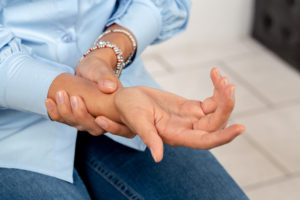How to Avoid Carpal Tunnel
The carpal tunnel, like a tunnel on the roadways, plays a huge role in funneling traffic. However, the carpal tunnel in the hand funnels nerve information, not cars.
Many of my patients who have carpal tunnel have had it for some time. People often initially notice their symptoms at night, but it eventually becomes problematic in the daytime. Typically, patients complain of pain in their hand and wrist (on the palm side), tingling/pins/needles (primarily in the thumb, index, long, and part of the ring finger), and inability to perform simple tasks.

There are two common causes of carpal tunnel: sleeping positions and repetitive tasks. When your wrist is kept in a downward, flexed position for hours, the nerve can get jammed. And like a wreck on the interstate, when there’s a jam, the roadways become slower and backed up. My patients often report waking up with a feeling like “my foot is asleep” in the hand and pain when they try to use their hands. Another common cause can be repetitive tasks. When you do the same thing over and over again, the body can become worn down. Our bodies are not meant to do the same thing over and over without a break.
If your carpal tunnel becomes an issue, remember the “CPR” of carpal tunnel: CHANGE, POSTURE, REST
CHANGE up the task you are doing.
Give your hand and wrist a break by changing things up as you go. For example, if you are assembling your child’s birthday present that has 1,000 pieces, take a break or use a different tool as you go. Giving your body a rest from the exact same position/ posture/task will help it succeed long term.
POSTURE in sleep and work.
When you sleep, avoid bending your wrist down for hours at a time. Commercial braces that are effective for this; I encourage patients to try different styles to find what works. When working at your desk, posture is also key to avoiding or managing your carpal tunnel. Be sure to sit in a chair that supports your neck. Hips, knees, and elbows should be comfortable around 90 degrees, and make sure to have a small support under your wrists for typing. (Like a gel pad or rolled up towel) The goal is to support your arms and body while being comfortable.
REST your hands and wrists when they are asking for a break.
We often ignore the body’s need for rest. A lot of what causes carpal tunnel syndrome is avoidable if you would listen to your body. Taking breaks in tasks, resting at the end of a long day (not on screens), and getting a good night’s sleep can prevent and/or help decrease symptoms of carpal tunnel syndrome.
Evelyn Daniel, OTR/L, CHT is a certified hand therapist at OrthoSouth’s Primacy Parkway clinic, where she works with orthopedic hand surgeon Tyler Cannon, MD to manage and rehabilitate conditions and injuries of the hand, wrist, and elbow. If you are concerned you have carpal tunnel syndrome, contact one of OrthoSouth’s hand surgeons for further evaluation at 901.641.3000.
This article was first published in the November 2021 issue of Memphis Health & Fitness magazine.

